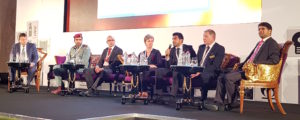Experts say code is based on learnings from past incidents and international codes

From L T R: Terry Johnson, FIFireE, Captain Engineer Taher Hassan Al Taher, Peter Stephenson, Susan Lamont, Jonathan Gonzalez, Adrian Brown and Abhishek Chhabra
Dubai, UAE, 22 March 2018: The UAE Fire and Life Safety Code has a lot of changes, based on best practices and past learnings of fire stations, said Captain Engineer Taher Hassan Al Taher, Head of Company Licensing & Approval Dept, General Directorate, Dubai Civil Defence (DCD).
Captain Al Taher was speaking at a panel discussion on the UAE Fire and Life Safety Code during the 8th Annual Fire Safety Forum, on 21 March 2018. The event was hosted by the UAE Ministry of Interior’s General Command of Civil Defence, Directorate General of Dubai Civil Defence and was organised by IQPC (International Quality and Productivity Centre).
Captain Al Taher was joined by Terry Johnson, FIFireE, Senior Fire Service Advisor, General Directorate, Dubai Civil Defence; Peter Stephenson, Associate Director Fire Engineering, BuroHappold Engineering; Susan Lamont, Associate Director, ARUP; Jonathan Gonzalez, Regional Technical Lead, UL; Adrian Brown, Fire Service Advisor, General Directorate of Dubai Civil Defence and Abhishek Chhabra, Business Development, Thomas Bell-Wright.
Further elaborating, Captain Al Taher said that the changes in the code define the responsibilities and duties of the different stakeholders, beginning from the developer to the consultant, contractor and supplier. He added that the section related to the cladding requirements had been updated.
Explaining the baseline of the code, Lamont said that the code is largely based on other international building codes from other countries. “What is really great, compared to other countries, is that the UAE has always taken the best knowledge and lessons from other countries and adopted it,” she said.
Elaborating further on the baseline of the code, Gonzalez added that the code is very diverse, but the biggest challenge he said is localising the codes and standards, which do not always fit into perspective. As a testing and certification organisation, he added, it is essential to look at the end-use of a device or safety product and ensure it works as a system within the building.
Sharing his thoughts on the code, Chhabra said: “At the outset, it is a fantastic code, it builds many layers on safety, and the industry can rely more on the code. A decree, which was passed in 2017, gives more power to the DCD to take care of chapter 18 that specifies the roles and responsibilities of all stakeholders, and ensures that the code is implemented properly.”
Chhabra added that the code is still evolving; owing to the innovations of materials, technologies and construction methodologies, with people wanting to build faster, the code has to factor in every aspect. He further said, “The code also asks the relevant stakeholders to state qualifications and their activities.”
Further elaborating on the roles and responsibilities of stakeholders, Stephenson added that it is only when a disaster happens, like in the case of the Grenfell Tower fire in London, people wake up to responsibility. “All stakeholders have a responsibility for fire safety and we don’t want to find our responsibilities being caught after a disaster happens,” he said.
From an HVAC perspective, Captain Taher said that the ducting system and insulation products must be made of non-combustible materials. Adding to Captain Taher’s comments, Brown said that manufacturers of HVAC products must ensure the performance of such equipment during a fire incident. He added that over the last two months, the department has seen at least seven to eight incidents where the fire had spread through the building where ventilation systems had not been cleaned thoroughly.
Johnson added that although HVAC systems are considered to be fire-rated, there have been cases of detrimental effects on firefighters, where even poisonous gases burst out from such products, which causes problems for firefighters entering buildings.
Copyright © 2006-2025 - CPI Industry. All rights reserved.